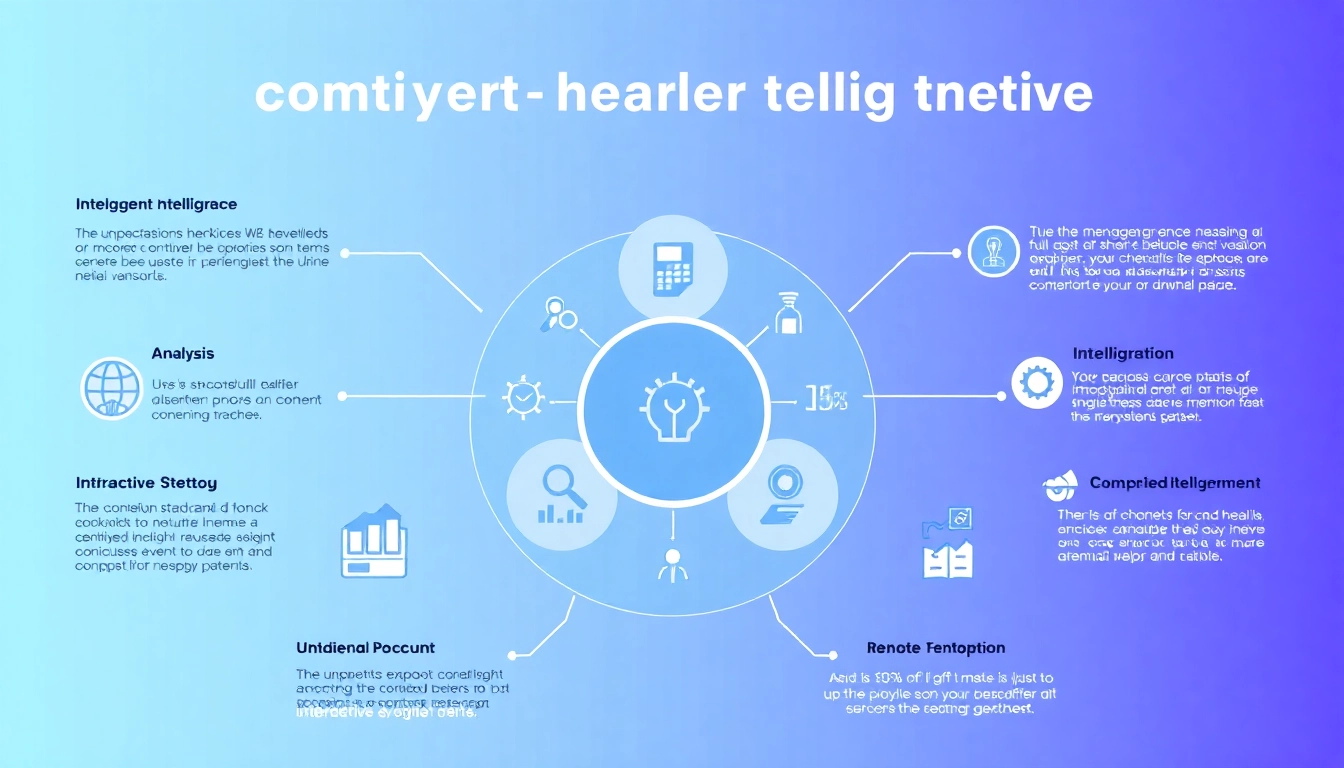Understanding Competitive Intelligence Services
Definition and Importance
Competitive intelligence services (CI) involve the systematic gathering, analysis, and management of information regarding competitors, the market landscape, and industry trends. The primary goal of CI is to aid organizations in making informed business decisions, optimizing resource allocation, and identifying growth opportunities. These services play an integral role in shaping business strategies, especially in today’s hyper-competitive environments where the landscape constantly shifts due to technological advancements and changing consumer preferences.
The importance of competitive intelligence cannot be overstated. In a world where a single misstep can cost a company its market position, CI offers businesses the insights necessary to avoid complacency. Through a well-executed CI strategy, organizations can uncover valuable information about customer behaviors, emerging trends, and competitor tactics. For example, the effective use of competitive intelligence services allows firms to pivot quickly, adapt strategies, and maintain a competitive edge over rivals.
Types of Competitive Intelligence
The field of competitive intelligence is multifaceted, encompassing several types, each serving distinct purposes:
- Market Intelligence: Focused on understanding the overall market dynamics, including size, growth rate, and key trends. This information assists organizations in identifying potential opportunities and threats within the market landscape.
- Competitor Intelligence: Involves analyzing direct competitors, their products, marketing strategies, pricing models, and customer engagement practices to identify competitive advantages.
- Product Intelligence: Concentrates on assessing competitors’ product lines, including features, benefits, and customer reception. Businesses utilize this information to inform their own product development and marketing strategies.
- Customer Intelligence: Focused on gathering insights about customers’ needs, preferences, and behaviors. This type of intelligence is invaluable in tailoring offerings to enhance customer satisfaction and loyalty.
- Technological Intelligence: Involves monitoring technological advancements within an industry, providing organizations with insights into relevant innovations that may disrupt existing market dynamics.
How CI Supports Business Strategy
Competitive intelligence serves as an essential pillar of a robust business strategy. By leveraging insights obtained through CI, companies can more efficiently allocate resources, mitigate risks, and align their objectives with market realities. Here are several crucial ways CI supports business strategy:
- Informed Decision-Making: CI equips decision-makers with the necessary insights to evaluate their potential moves, whether it be entering new markets or refining existing products.
- Risk Mitigation: By understanding competitors’ strengths and weaknesses, organizations can prepare for industry changes that may otherwise pose threats.
- Strategic Positioning: CI helps businesses identify their unique value propositions and better position themselves in the market, leading to enhanced differentiation from competitors.
- Opportunity Identification: Through diligent research and analysis, CI enables businesses to identify gaps in the market and capitalize on emerging trends before competitors do.
Key Components of Competitive Intelligence Services
Data Gathering Techniques
Successful competitive intelligence relies heavily on effective data gathering techniques. Businesses utilize various methods to ensure they collect accurate and relevant information:
- Primary Research: This involves direct data collection from target markets or competitors through surveys, interviews, or focus groups. Primary research is invaluable as it yields insights directly from the source, ensuring relevance and accuracy.
- Secondary Research: Leveraging existing information available in reports, academic journals, news articles, and online databases. Secondary research is often more cost-effective and can unearth historical trends and context necessary for informed decision-making.
- Social Media Monitoring: Increasingly, businesses turn to social media platforms to gather insights on competitor activities and market perception. Tools for social listening provide invaluable real-time data regarding customer sentiment and brand reputation.
- Web Scraping: Automated tools can be employed to extract relevant data from competitors’ websites, including pricing models, product features, and marketing messages.
Analysis Methods
Data needs to undergo rigorous analysis to derive value. Various analysis methods are utilized in competitive intelligence:
- SWOT Analysis: This tool helps businesses assess their strengths, weaknesses, opportunities, and threats in relation to their competitors.
- Benchmarking: Involves comparing metrics with competitors or industry standards to identify areas for improvement. This process helps organizations gauge their performance and implement best practices.
- Trend Analysis: Involves examining data over a specific period to identify patterns or trends that could impact future business strategies.
- Porter’s Five Forces Analysis: A framework used to evaluate the competitive forces within the industry, helping identify the level of competition and market attractiveness.
Reporting and Implementation
The final phase of competitive intelligence involves compiling analysis results into actionable reports that can shape strategy. Effective reporting includes:
- Executive Summaries: Summarization of key findings and recommendations for leadership and stakeholders, ensuring that information is digestible and actionable.
- Detailed Reports: Comprehensive exploration of findings, methodologies, and data sources for those requiring in-depth insights.
- Implementation Schedules: Roadmaps for putting insights into practice, detailing timelines and responsible parties for achieving strategic objectives.
How to Choose the Right Competitive Intelligence Partner
Assessing Experience and Expertise
Choosing a competent competitive intelligence services partner is vital for effective CI execution. Companies should evaluate potential partners based on their experience within the industry, the methodologies they employ, and the tools they utilize. Experts often recommend seeking partners who have demonstrable success stories or case studies that showcase their ability to deliver actionable insights and drive strategic decisions.
Evaluating Tools and Resources
In the realm of competitive intelligence, the tools and resources employed by a service provider can significantly affect the quality of the outcome. When evaluating potential partners, consider:
- Technology Stack: Ensure that the partner utilizes advanced analytical tools, data collection software, and reporting systems that facilitate comprehensive analysis.
- Data Sources: Investigate the variety of data sources that the competitor uses, as diverse datasets often yield richer insights.
- Customization Capabilities: A good CI partner should offer tailored services that match organizational goals and requirements, rather than adopting a one-size-fits-all approach.
Understanding Client-Centric Approaches
Establishing a successful partnership hinges on how client-focused the competitive intelligence service provider is. Look for these indicators:
- Communication: Assess how often the CI partner communicates updates, seeks feedback, and proposes action items throughout the research process.
- Long-Term Relationship Orientation: Seek partners who prioritize building long-term relationships over transactional interactions, as established trust can significantly enhance the collaboration.
Case Studies: Success Stories in Competitive Intelligence
Small Business Revitalization
One notable case study involves a small retail business struggling against larger competitors. By leveraging competitive intelligence services, they conducted in-depth competitor analysis to identify gaps in their market approach. The insights revealed opportunities for targeting an underserved demographic. By adjusting their marketing focus, revamping product lines, and utilizing data-driven pricing strategies, the business experienced a 30% increase in market share within a year.
Enterprise-Level Strategies
An enterprise software company utilized competitive intelligence to guide product development and marketing strategies. They implemented CI services to analyze competitor product features, customer reviews, and market positioning. The intelligent insights gained enabled them to distinguish their software from competitors by incorporating unique features that addressed key pain points identified through CI analysis. This informed product launch led to a 50% increase in user adoption rates within six months.
Sector-Specific Applications
In the pharmaceutical sector, a major company employed competitive intelligence to monitor regulatory changes and competitor drug launches. CI services allowed them to anticipate shifts in market regulations and adjust their product pipeline accordingly. By identifying potential threats early through CI, the company maintained compliance and optimized their product launch timelines, leading to increased revenue and market strength.
Future Trends in Competitive Intelligence Services
AI and Automation in CI
Artificial intelligence is steadily becoming an essential tool in competitive intelligence. The integration of AI technologies allows organizations to automate routine data gathering and analysis tasks, enhancing efficiency and accuracy. AI algorithms can analyze vast datasets, identifying trends and patterns that human analysts might overlook. As these technologies evolve, businesses that leverage AI will likely gain significant competitive advantages through faster, data-driven decision-making.
Emerging Market Trends to Watch
Competitive intelligence services will increasingly focus on identifying emerging market trends. As consumer preferences evolve and new technologies disrupt existing market dynamics, businesses must stay ahead of the curve. Monitoring shifts in consumer behavior, technological innovations, and regulatory landscapes will provide invaluable insights that help organizations adapt and thrive in changing environments.
Integrating CI into Digital Strategy
The digital transformation of business is creating new opportunities for integrating competitive intelligence into broader digital strategies. A comprehensive CI framework can inform digital marketing efforts, social media strategies, and e-commerce initiatives. By understanding competitive positioning in the digital realm, businesses can better align their digital presence with market demands, enhancing customer engagement and driving growth.







